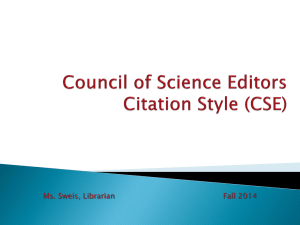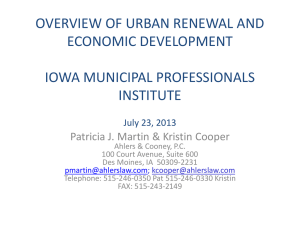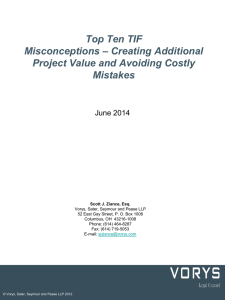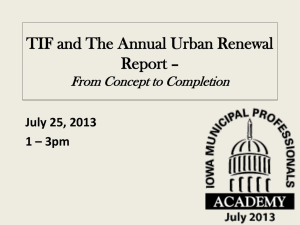Research Integrity - Johns Hopkins Medicine
advertisement
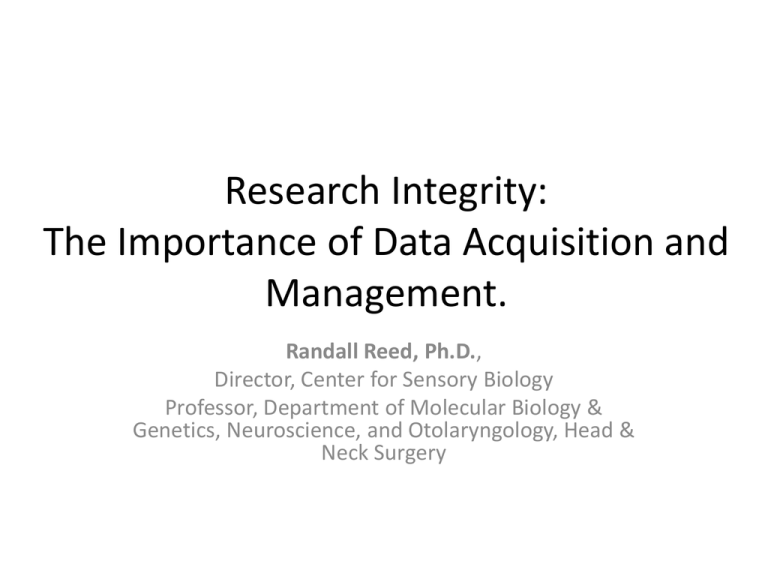
Research Integrity: The Importance of Data Acquisition and Management. Randall Reed, Ph.D., Director, Center for Sensory Biology Professor, Department of Molecular Biology & Genetics, Neuroscience, and Otolaryngology, Head & Neck Surgery Disclosures No Relevant Financial Relationships with Commercial Interests Data Acquisition and Management • The Original Record- What is it? – Contemporary Challenges of Primary data – Nature/Volume • The Pathway to Publication – Perspectives from the participants – Data processing – Wrongs and Rights • Data Retention and Organization – Requirements for Retention – The importance of Organization Primary Data – A look back • The Structure of DNA – Rosalind E. Franklin Data Explosion(s) Genetic and Genomic Information R. Reed PNAS 1981 Illumina.com Data Explosion(s) Imaging and Visualized Information The sheer Volume of data that supports/incorporated into publications has accelerated by many orders of magnitude!! Similar Data Explosions are Occurring in almost all areas of Biomedical Research • Complex multi-modal databases of Human Subjects information in Clinical Studies • Recordings of functional activity in brain by fMRI and multi-electrode • Microbiome genomic information The Current Reality • Bench/Bedside Biomedical Scientists responsible for data collection are more detached from the Primary Data underlying their research • More analysis is done on a representation(s) of Primary Data • PIs are especially distant because of volume and representations Questions for Discussion: • What is “Primary Data”? • Do I really need to keep it all? • Do I really need to use it all? Data Acquisition and Management • The Original Record- What is it? – Contemporary Challenges of Primary data – Nature/Volume • The Pathway to Publication – Perspectives from the participants – Data processing – Wrongs and Rights • Data Retention and Organization – Requirements for Retention – The importance of Organization A Student’s Perspective on Publication: A Time Line…. Design Experiment Collect Data Re-Design Experiment Collect More Data Make Powerpoint: Present Data at Lab Meeting Time Do Experiment for Publication Repeat Experiment – Get Good Data for Publication Make Draft of Publication Figs More Time SUBMIT !!! Give to PI to Write Paper Improve Appearance of Figures A PI’s Perspective on Publication: Design Experiment w/ Student/Postdoc Wait Inquire about Progress Wait See Data at Lab Meeting PI Excited: Tell Student Time to Write His Paper Time - YEARS PI Gets Draft Figures PI asks Student if Better Images Exist PI Improves + Approves Final Figs PI Writes Paper Time - WEEKS What’s Wrong with these Scenarios?? PI Submits!!! Two Collaborators’ Perspective on Publication: MY DATA HER DATA MY PAPER Data Processing and Manipulations • Cases of Fraud/Fabrication – Probably more common than we appreciate – Still relatively rare – Recent changes are improving detection • Excessive/Inappropriate Data manipulation – Done to “assist” the reader – Eliminate “distractions” – Make “Best ever” data appear “typical” Data Processing: Wrongs and Rights Original image Remove graininess with blur original Adjust levels and contrast Clean up “background” Automated Image Analysis and Reconstruction Mixed re-colored channels Traditional image Evolving Standards for Data Presentation • Journals have promulgated standards for acceptable image manipulations – not standardized across journals – Sometimes vague – Original data depository (Journal of Cell Biology) • Journal Editors have become very proactive in “image forensics” Data Acquisition and Management • The Original Record- What is it? – Contemporary Challenges of Primary data – Nature/Volume • The Pathway to Publication – Perspectives from the participants – Data processing – Wrongs and Rights • Data Retention and Organization – Requirements for Retention – The importance of Organization The Essentials of Data Retention • For most NIH Grants need to retain Data for: – 3 years after filing of final reports at end of grant – Longer for clinical studies – even longer is some circumstances • Data is retained by Institution – Accessible to the PI and other authors • Free to make copies – All Original Data must stay with host Institution • Includes notebooks, raw files, associated records Requirements for Data Retention • Primary Data needs to be stored in a secure place – Not on a laptop or a USB memory stick – Permanent storage – Backed up – Secured against theft and tampering • Data needs to be Organized to be effectively managed Organizing Data from Acquisition to Publication • Assemble raw data and finished figures in one location • Retain steps in editing figures as they are assembled • Prepare tables that indicate the permanent storage location of the original data including all identifiers • Compare final figure to assess whether is it an accurate representation of original data Organizing Data from Acquisition to Publication An example: (AcTub wt) AD994 AcTub single a.tif (AcTub KO) AD996 AcTub single a.tif (i7/ac3 wt) AD994 I7 AC3 proj b.tif (i7/ac3 KO) AD996 I7 AC3 proj b.tif (i7/slp3 wt) AD994 I7 SLP3 proj b.tif (i7/slp3 KO) AD996 I7 SLP3 proj b.tif “Images” “BBS8” 92.1 92.1 92.1 92.1 92.1 92.1 10um 10um 10um 10um 10um 10um Allows permanent connection between published materials and the original source data!! Best Practices: Data Acquisition and Management • Data should be organized from earliest collection with cross-correlation regarding all identifiers • Organization principles should be familiar to experimenter and PI. • Everyone Involved in Publication should undertake Post-hoc review of final figure and original data and ASK: – “Is this an accurate representation of our observations?” • All Data should be available to all authors on request Panel Discussion • • • • Randall Reed, Ph.D. Frederic Luthardt, M.A., M.A. Marquis Walker, Ph.D. Sarah Wheelan, M.D., Ph.D. • Sheila Garrity, J.D., M.P.H., M.B.A. – Moderator

